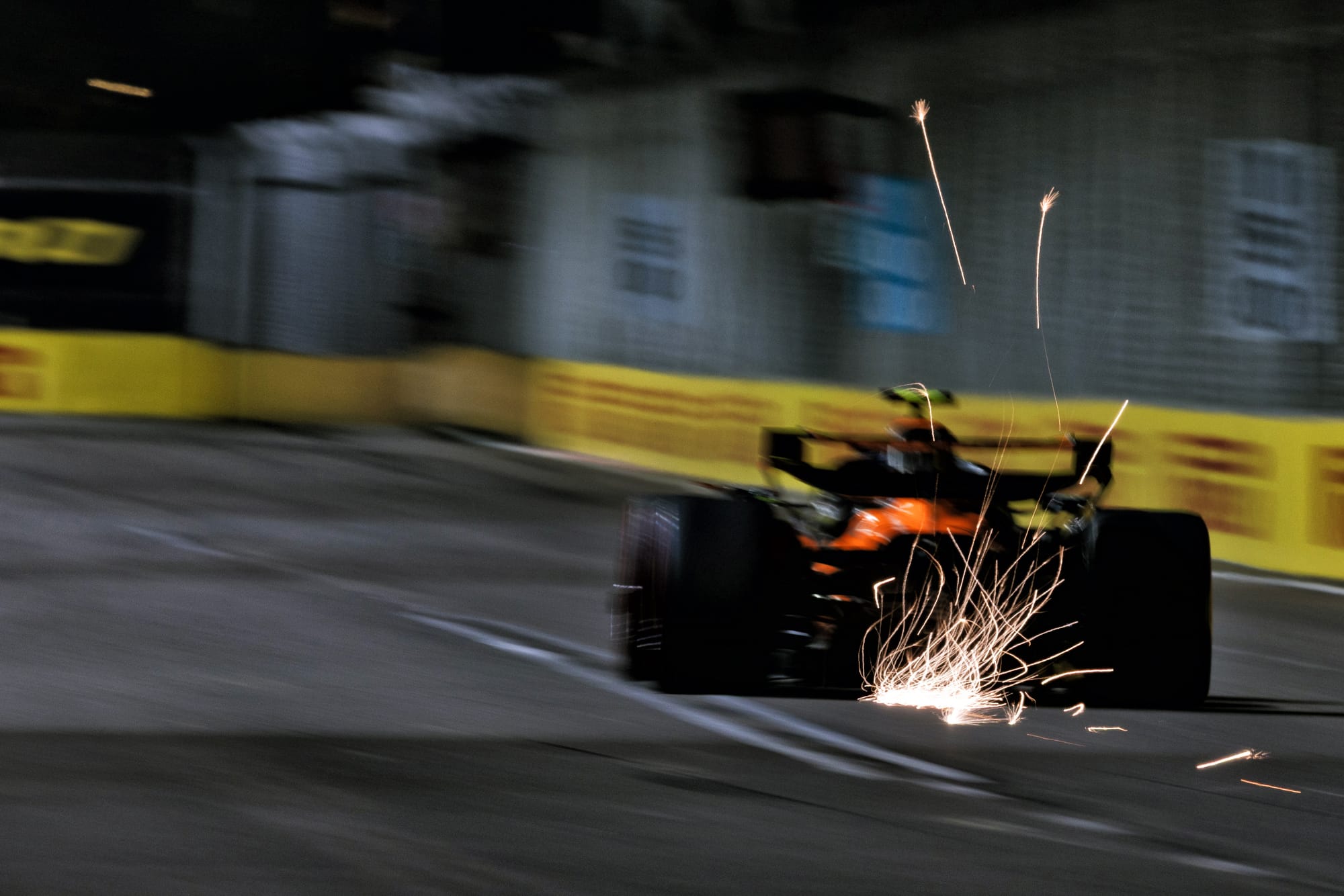The root cause of McLaren’s double disqualification in the Las Vegas Grand Prix lies in the team’s cautious set-up choices inadvertently triggering unexpected porpoising.
McLaren drivers Lando Norris and Oscar Piastri were disqualified from second and fourth in Vegas after their cars breached F1’s rules around minimum skid block thickness after the race.
The team’s initial explanations on Saturday night in Vegas, then again on Thursday ahead of this weekend’s race in Qatar, were that there had been unexpected aerodynamic oscillations (porpoising) causing the car to ground excessively over the course of the race.
McLaren has also been emphasising the margin it took in setting its car up for qualifying and the race, after limited dry running in practice, because the root cause of the excessive wear was not the car running too low - which is what would typically be assumed when a car is too aggressive on its plank.
As Norris said on Thursday in Qatar: “The issue was the porpoising, it wasn't because we were just running low. Sometimes it can be the opposite.”
McLaren’s cautiousness on the set-up most likely means running slightly higher rear ride height than normal, and while it seems counter-intuitive, running the car higher ultimately caused more wear because of what it led to.
What dry running there was in practice had not indicated to McLaren that it would suffer from porpoising, which is a rapid series of detachments and reattachments of the airflow under the floor causing it to rise up then get sucked back to the ground again several times per second.
Porpoising was initially a major problem at the start of the ground-effect rules in 2022 but has only occasionally been a talking point since 2023. In Vegas, it unexpectedly returned for McLaren to such a severe extent that those oscillations were causing significant impacts with the track surface.
This is what wore the skids on the McLaren more than usual, rather than the team being too aggressive in judging the ride height demands of the street track after compromised practice sessions.
The slightly higher ride height it pitched the car at for Vegas, combined with the high-speed and bumpy nature of the circuit, moved it into a window where it was vulnerable to porpoising, which can be triggered in different ways. For example, bumps in the track surface can initiate airflow disruption.
Had McLaren actually been more aggressive with its ride height choices, it probably would have been better off in terms of the eventual skid wear it suffered. This is what Norris alluded to on Thursday when he said “in some ways you can almost say we didn't take enough risk”.
Again, it is slightly counter-intuitive to suggest running lower would wear the plank less, but that is because of the specific problem McLaren suffered, which speaks to the complex nature of these cars and the physics involved.
The car would have been lower, but would not have been grounding so aggressively as the porpoising phenomenon would probably not have been triggered.
That also partly explains why the attempted mitigation - to lift and coast at the fastest parts of the track, so the car was not pulled to the track surface as much and would theoretically ground less - was not very effective. In fact, in some places, it made it worse.
This again suggests that higher rear ride height was a confounding factor as the rear would run higher when lifting off throttle.
“It's not as simple as just looking at it and going, ‘ah they did that and that's why they are quick’,” Norris said when asked if McLaren could take risks with the ride height in Qatar and Abu Dhabi after the disqualification.
“In fact, we were slower because of the issues that we had, not quicker.
“Every team, when you're in Formula 1, you're fighting for race wins and everything, you always have to push things to the limit.
“That's not meaning that's exactly what we did in Las Vegas, because it's a lot more complicated [than that].”
Gary Anderson: A question of fine margins

The height of the rear of these cars is critical to porpoising. The porpoising is set in motion as small sections of the underfloor and the area leading through to the diffuser suffer from airflow separation at certain ride heights.
If you are going in and out of that critical ride height, then that’s when the porpoising starts. And if the increase in downforce from the underfloor and diffuser relative to the increase in car speed is not enough to keep compressing the car towards the ground, then the porpoising will just increase and the car will start banging into the ground and wear the skids and plank more than normal.
I would say that the lower downforce rear wings, which produce less downforce and with it drag, that McLaren ran in Vegas explain why the car's porpoising got out of control.
Basically, the overall increase in downforce with speed was not enough to overcome the underfloor separation downforce loss.
A lower ride height would have meant that the airflow separation in the underfloor would have happened at a lower speed.
This means the rear wing's influence on the car's overall load, with more of a speed increase to increase the overall load on the car, would keep the car in the underfloor separation area so stabilise the cars porpoising movement.
Or, simply a higher level of rear wing downforce would have overcome the underfloor losses and kept the car in the airflow separation area as opposed to it bouncing in and out of that critical area.
It just shows how critical the set up of these cars are.



